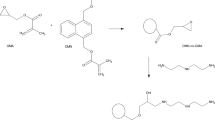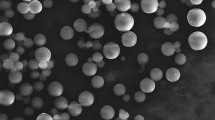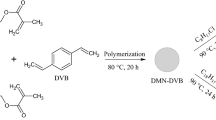Abstract
The series of highly crosslinked, hydrophilic stable spherical microspheres based on the new aromatic tetrafunctional methacrylate monomers and divinylbenzene (DVB) were prepared by emulsion–suspension polymerization in the presence of pore-forming diluents (toluene/decan-1-ol). The new monomers were generated by treatment of epoxides derived from various diphenols: naphthalene-2,7-diol (NAF-2,7) naphthalene-2,3-diol (NAF-2,3), bis(4-hydroxyphenyl)methanone (BEP) or 4,4′-thiodiphenol (BES), and epichlorohydrin with methacrylic acid. The copolymerization process of new methacrylate monomers with DVB was carried out at constant mole ratio of methacrylate monomers: DVB (1:1) and constant volume ratio of pore-forming diluents to monomers (1:1) using α,α′-azoisobisbutyronitrile (AIBN) as initiator. The effect of the structure of new methacrylate monomers on the surface appearance, porous structure, swelling behavior in polar, and non-polar diluents as well as thermal properties of obtained copolymer beads was evaluated. The obtained results confirmed that the monomer’s structure considerably influenced on the microspheres characteristic. In general, higher swelling properties of dimethacrylic/divinylbenzene copolymers were observed in polar diluents due to the presence of polar groups: hydroxyl and ester groups in copolymer’s structure. Moreover, both the swelling properties of dimethacrylic/divinylbenzene copolymers as well as thermal properties studied by DSC and TG analysis confirmed that diacrylic/divinylbenzene copolymers described in previous article were more crosslinked compared to those actually studied. It was attributed to the presence of additional groups (methyl groups) in dimethacrylic/divinylbenzene copolymer’s structure and thus producing of more flexible polymeric networks due to the steric hindrance.



Similar content being viewed by others
References
Hradil J, Wojaczyńska M, Svec F, Kolarz BN. Sorption of phenols on macroporous methacrylate copolymers containing ethyleneamine groups. React Polym. 1986;4:277–83.
Narasimhaswamy T, Reddy BSR. Phenyl acrylates and divinylbenzene cross-linked copolymers as basic novel supports: synthesis and characterization. J Appl Polym Sci. 1991;43:1645–57.
Azanova VV, Hradil J. Sorption properties of macroporous and hypercrosslinked copolymers. React Funct Polym. 1999;41:163–75.
Smigol V, Svec F. Synthesis and properties of uniform beads based on macroporous copolymer glycidyl methacrylate-ethylene dimethacrylate: a way to improve separation media for HPLC. J Appl Polym Sci. 1992;46:1439–48.
Smigol V, Svec F. Preparation and properties of uniform beads based on macroporous glycidyl methacrylate-ethylene dimethacrylate copolymers: use of chain transfer agent for control of pore-size distribution. J Appl Polym Sci. 1993;48:2033–9.
Gawdzik B, Gawdzik J, Czerwińska-Bil U. Copolymer of di(methacryloyloxymethyl) naphthalene and divinylbenzene as a column parking for high-performance liquid chromatography. Chromatographia. 1988;26:399–407.
Gawdzik B, Osypiuk J. Reversed-phase high-performance liquid chromatography on porous copolymers of different chemical structure. J Chromatogr A. 2000;898:13–21.
Gawdzik B, Podkościelna B. An influence of diluent composition on the porous structure of 4,4′-diphenyl dimethacrylate-divinylbenzene copolymers. Annales UMCS. 2005;LX:282–95.
Gawdzik B, Podkościelna B, Bartnicki A. Synthesis, structure and properties of new methacrylic derivatives of naphthalene-2, 3-diol. J Appl Polym Sci. 2006;102:1886–95.
Podkościelna B, Gawdzik B, Bartnicki A. Use of a new methacrylic monomer, 4, 4′-di(2-hydroxy-3-methacryloyloxypropoxy)benzophenone in the synthesis of porous microspheres. J Polym Sci Part A Polym Chem. 2006;44:7014–26.
de Santa Maria LC, Aguiar MRMP, D’Elia P, Ferreira LO, Wang SH. The incorporation of polar monomers in copolymers based on styrene and divinylbenzene obtained from glycerol suspension polymerization. Mater Lett. 2007;61:160–4.
Ishizu K. Synthesis and structural ordering of core-shell polymer microspheres. Prog Polym Sci. 1998;23:1383–408.
Luciani A, Coccoli V, Orsi S, Ambrosio L, Netti PA. PCL microspheres based functional scaffolds by bottom-up approach with predefined microstructural properties and release profiles. Biomaterials. 2008;29:4800–7.
Guo G, Huang Y, Zhang Y-Y, Zhu L-R, Zhang B-L. Curing behavior of epoxy resins with a series of novel curing agents containing 4,4′-biphenyl and varying methylene units. J Therm Anal Calorim. doi:10.1007/s10973-010-0764-2.
Vijayakumar CT, Surender R, Rajakumar K, Alam S. Synthesis and thermal studies of bisphenol-A based bismaleimide. Effect of nanoclays. J Therm Anal Calorim. doi:10.1007/s10973-010-1020-5.
Worzakowska M. Curing reaction of unsaturated (epoxy) polyesters based on different aliphatic glycols. J Therm Anal Calorim. doi:10.1007/s10973-009-0600-8.
González M., Cabanelas JC, Pozuelo J, Baselga J. Preparation of cycloaliphatic epoxy hybrids with non-conventional amine-curing agents. J Therm Anal Calorim. doi:10.1007/s10973-010-0980-9.
Rzączyńska Z, Kula A, Sienkiewicz-Gromiuk J, Szybiak A. Synthesis, spectroscopic and thermal studies of 2,3-naphthalenedicarboxylates of rare earth elements. J Therm Anal Calorim. doi:10.1007/s10973-010-0927-1.
Podkościelna B, Worzakowska M. Synthesis, characterization and thermal properties of diacrylic/divinylbenzene copolymers. J Therm Anal Calorim. 2010;101:235–41.
Podkościelna B, Bartnicki A, Gawdzik B. Porous microspheres, copolymers of bis[4-(2-hydroxy-3-methacryloyloxypropoxy)- phenyl]sulfide and divinylbenzene as stationary phase for HPLC. J Appl Polym Sci. 2009;11:1257–67.
Podkościelna B, Gawdzik B. Influence of diluent compositions on the porous structure of methacrylate derivatives of aromatic diols and divinylbenzene. Appl Surf Sci. 2010;256:2462–7.
Tuncel A, Pişkin E. Nonswellable and swellable poly(EGDMA) microspheres. J Appl Polym Sci. 1996;62:789–98.
Kesenci K, Tuncel A, Pişkin E. Swellable ethylene glycol dimethacrylate-hydroxyethylmethacrylate copolymer beads. React Funct Polym. 1996;31:137–47.
Author information
Authors and Affiliations
Corresponding author
Rights and permissions
About this article
Cite this article
Podkościelna, B. The highly crosslinked dimethacrylic/divinylbenzene copolymers. J Therm Anal Calorim 104, 725–730 (2011). https://doi.org/10.1007/s10973-010-1184-z
Received:
Accepted:
Published:
Issue Date:
DOI: https://doi.org/10.1007/s10973-010-1184-z




